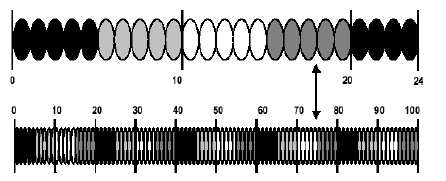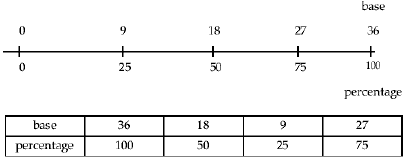Know benchmarks for converting between common fractions, decimals and percentages
Number Framework Stage 7
Percentage Strips Material Master 7-4)
paper clips
To become strong proportional thinkers, the students need to be able to find multiplicative relationships in a variety of situations involving fractions, decimals, ratios, and proportions. These situations include:
Proportion: How part of a set or quantity relates to the whole, for example, “Is 13 out of 20 a better result than 32 out of 50?”
Ratio: How a set or quantity compares with another, for example, “A class has 6 adults to 28 students on a field trip. Do they meet the required adult : student ratio of 1:5?”
Fractional/Decimal Operators: The result of finding a fraction of a set or quantity, including other fractions, for example, “The petrol tank holds 41.7 litres. The car used two-thirds of a tank-full in one trip. How many litres was that?”
It’s important that the students understand the relationships between these three views of fractional (rational) numbers. For example, a ratio of two reds to three blues (2:3) can be interpreted as the proportion two fifths (2/5) of the set or quantity being red.
The fraction 2/5 can also be used as an operator, as in, “There are 45 beads. Two fifths of them are yellow. How many are yellow?”
Ratios and proportions can also be represented as decimals and percentages, e.g., 2/5 = 0.4 (equivalent to four-tenths) = 40% (equivalent to 40 hundredths).
Using Equipment
Discuss a situation where the students have encountered percentages in their daily life. They will often suggest sports (for example, shooting for goal), shopping (such as, discounts or GST), and, in country areas, calving or lambing percentages. Tell the students that the % sign comes from the “out of” symbol, /, and the two zeros from 100. It means, ”Out of 100.”
Problem: “In a game of netball, Irene gets 43 out of her 50 shots in. Sharelle takes 20shots and gets 17 in. Who is the better shot?” Tell the students that percentages are used to compare fractions. In Irene’s case the fraction is 43/50 . Doubling 43 calculates the shooting percentage, as 43/50 is equivalent to 100 86. Represent this on a double number line.
Ask the students to work out what Sharelle’s shooting percentage was for the same game. Represent this on a double number line to show that finding a percentage is like mapping a proportion onto a base of 100.
Pose the students a percentage problem that can be modelled with the percentage strips. For example: “Tony got 18 out of his 24 shots. What percentage did he shoot?”
Mapping 18 out of 24 onto a base of 100 gives 75%.
Pose similar problems that the students can solve by aligning differently based strips with the 100-base strip. Examples might be:
16 out of 32 (50%) 9 out of 36 (25%) 10 out of 25 (40%)
12 out of 16 (75%) 12 out of 40 (30%) 4 out of 20 (20%)
Using Imaging
Show the students the base strip, but have the percentage strip aligned to it but turned over so they can’t see the beads. Give the students “out of” problems and have them estimate the percentage by visualising.
For example, pose six out of 16. Mark six with a paper clip. The students should estimate the percentage as just below 40% or greater than 33.3% (one-third). A calculator can be used to work out the exact percentage by keying in 6 ÷ 16 %. The percentage strip can then be turned over to check the estimate. Ask how else they could have estimated the percentage if there had been no strips.
Look for ideas like “Six out of 16 is the same as three out of eight, and that is half of three out of four” or “There are over six sixteens in 100.Six times six is 36, so it will be more than 36 percent.”
Pose similar imaging problems like:
8 out of 20 (40%)
15 out of 25 (60%)
4 out of 16 (25%)
32 out of 40 (80%)
20 out of 32 (62.5%)
14 out of 36 (39%)
Focus on strategies based on the numbers involved that could have been used to estimate the percentages.
The students can play the game of Percents (Material Master 7-5) to consolidate their visualisation.
Using Number Properties
Give the students percentage problems to solve. Pose these problems in contexts of sports scores, shopping discounts or mark-ups, or lambing percentages. Pose some problems where duplication of the base onto 100 is not easy. For example 25 is easily mapped onto 100 through multiplying by four, 40 is not so easily mapped. Examples that involve percentages greater than 100 should also be used.
Some examples might be:
18/24 = %? (75%)
25/40 = %?(62.5%)
18/27 = %?(66.6 %)
8/32 = %?(25%)
24/16 = %?(150%)
55/20 = %?(275%)
Get the students to record their thinking using double number lines or ratio tables, e.g., 27/36 = 75%.
Independent Activity
Use brochures from local retailers. Tell the students that one shop has a “25% off”sale, another has a “40% off” sale, and a third has a “one third off” sale. Give the students an arbitrary budget to spend at the three shops.



